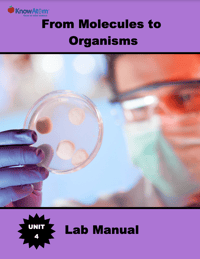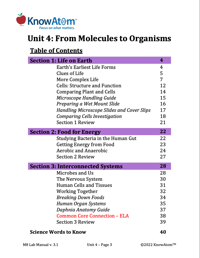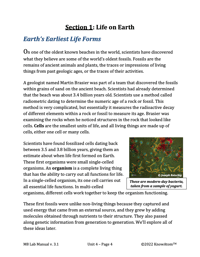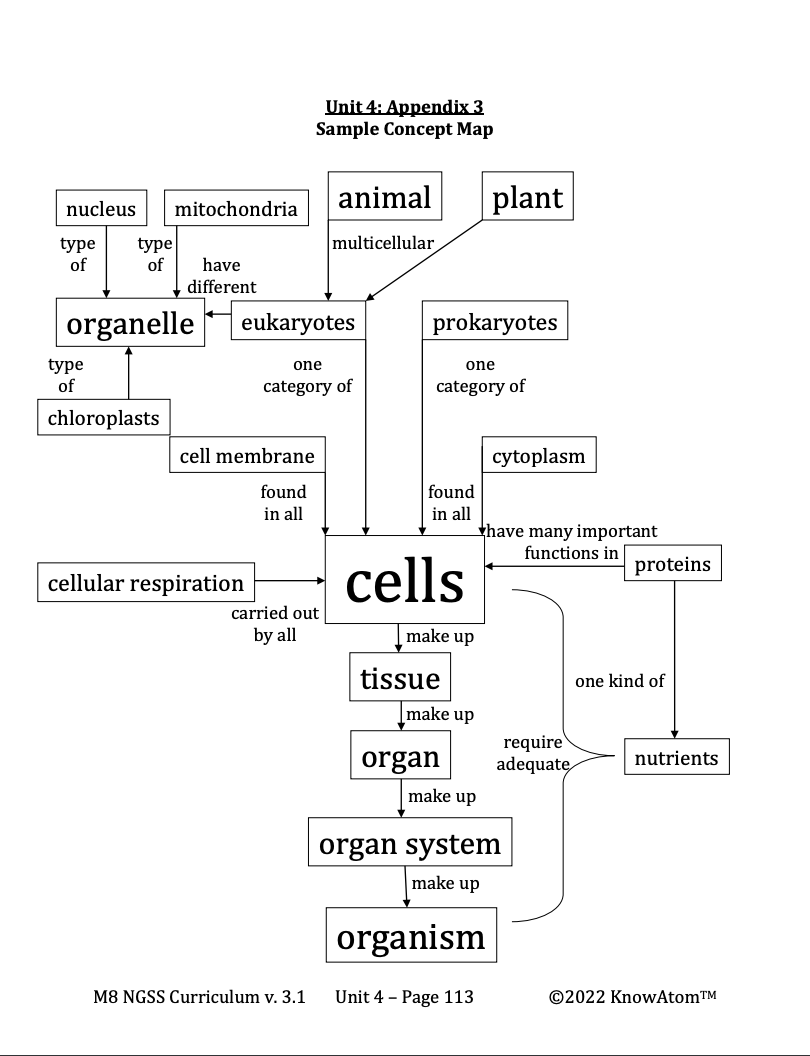The science background for teachers provides additional information on the phenomena students explore. Below is an excerpt from this section on cells.
Different Kinds of Cells
The earliest life forms on Earth were a kind of cell called prokaryote (pronounced proh- kar-ee- ote). The word prokaryote means “before nucleus.” They are called this because of their simple structure. They don’t have a nucleus to hold their genetic material, which is stored in DNA, or other membrane-bound organelles. Organelles are small parts that carry out specific functions in a cell.
Instead, their DNA is spread throughout cytoplasm—the jelly-like liquid that fills a cell and holds its structures. This simple structure is an advantage because any nutrients they absorb go directly to where they are needed. Almost all prokaryotes also have a cell wall, which is a stiff, shell-like wall that surrounds the cell membrane and protects it. Many prokaryotes move around using long tails called flagella. Like all organisms, both those alive today and those earliest life forms, prokaryotes need food, which provides energy and nutrients. Some prokaryotes use their flagella to move them toward food sources. Prokaryotes that don’t have flagella can use their membrane to engulf food sources.
Prokaryotes still exist. In fact, bacteria are some of the most abundant organisms still alive today. There even exist bacteria similar to the fossilized remains, which are common in ditches, soil, hot springs, and hydrothermal vents. Scientists believe that the similarities between modern bacteria and ancient fossils are evidence that the modern organisms are descended from those ancient life forms.
For billions of years, only prokaryotes existed on Earth. At some point, a new kind of cell called a eukaryote (pronounced yoo-KAR-ee-ote) first appeared. Scientists have pieced together this timeline by studying the fossil record, which includes all of the fossils that have ever been found. Scientists use the fossil record to understand Earth’s history.
Eukaryotes Emerge
However, the fossil record is incomplete because very few organisms actually become fossils. Because of this, there remains a lot of debate about the exact timeline for how life developed. Most scientists agree that by 2.7 billion years ago, complex eukaryotes had appeared on Earth. Eukaryotes are similar to prokaryotes because like all cells, they are surrounded by a cell membrane, they extract and use energy, they grow, and they reproduce, passing along genetic information.
However, eukaryotes are different from prokaryotes because they are more complex. For example, eukaryotes have many specialized organelles that deliver nutrients to where they are needed in the cell. The word eukaryote means “with nucleus.” The nucleus is the control center of eukaryote cells because it contains the organism’s genetic information, which like prokaryotes is stored in DNA. Eukaryotic cells are many times larger than prokaryotic cells, between 2 and 10 micrometers in length. Scientists believe the presence of the organelles allows these larger cells to function efficiently.
There is a lot of debate about how exactly eukaryotes came to be. Scientists piece together multiple pieces of evidence to find arguments for how life has changed over time, but there are multiple possible hypotheses. Many scientists believe that the first eukaryotes were single-celled organisms that developed in several stages, beginning around 2 billion years ago.
Evidence for Relationship Between Prokaryotes and Eukaryotes
In the first stage, a prokaryotic cell’s membrane may have folded inward to form the nucleus. Then, evidence suggests that this new kind of cell with a nucleus swallowed a smaller prokaryote. The swallowed prokaryote didn’t disappear, but remained alive inside the larger host cell. The two organisms developed a symbiotic relationship, where both organisms benefited from their partnership. The host cell—the one engulfing the other cell—would have benefited from the energy produced by the smaller cell, and the smaller cell would have been protected by the larger cell. Over time, the smaller, engulfed cell became a specialized organelle that couldn’t survive outside of the larger cell. We call this specialized organelle mitochondrion. The mitochondria (pronounced mite-oh-KAHN-dree- ah) are the power centers of the cell. They combine sugar from food with oxygen to produce molecules that the cell uses for energy.
The fossil record tells scientists that at some point after cells developed mitochondria, certain cells engulfed a kind of prokaryote called cyanobacteria. Cyanobacteria are different from other forms of bacteria because they perform photosynthesis—the process of turning sunlight, carbon dioxide, and water into glucose and oxygen. Photosynthesis provided cyanobacteria with their own food source.
These cyanobacteria duplicated within the larger eukaryotes and were passed down to future cells. Over time, the cyanobacteria became specialized organelles called chloroplasts, which are only found in plant cells. Chloroplasts contain a green pigment called chlorophyll, which gives plant cells their green color. It also absorbs sunlight, which begins the process of photosynthesis. The fact that all eukaryotic cells have mitochondria but only plant cells have chloroplasts tells scientists that the development of the chloroplasts came after the development of the mitochondria.








